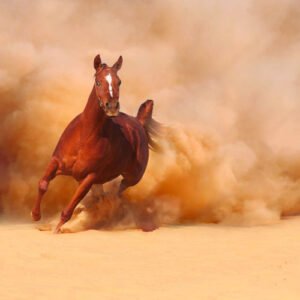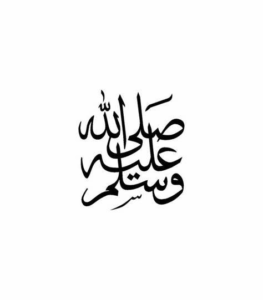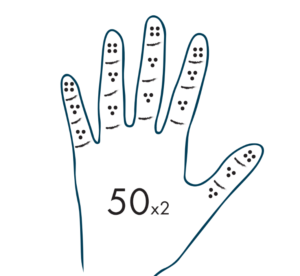How and where was the Seal of prophethood of Rasul Allah Muhammad Sallalahu alaihe Wa Sallam?
There are 8 riwayats about the seal of Rasul Allah Sallalhu alaihe Wa Sallam. If we gather all the riwayats together, we realize;
- It was Ghuddatul hamraa: One sahabi says when asked about the seal it is as if someone has closed a fist and put it behind the back of Nabi ﷺ yani a piece of sticking out flesh, ghuddatul hamraa’.(clenched fist) A big piece of flesh sticking out.
- It was Sha’arath mujtamiaath: It was a combination of hair – hair around it or a combination
- It was like a partridge egg – kabutri ka anda, birds egg.
- It was like a big button – big buttons on nets around a bed, button of a tent. Gundi on a tent.
- Lahmun nabit – Some say a protruding piece of flesh/sticking out piece of flesh.
How do we reconcile between these ta’beeraat ?
It was something that grew and sometimes it became small. It was narrated however the sahaba رضوان الله أجمعين saw it, at the time they saw it, they related it. So there is no ta’aruzh تعارض between the riwayat – they just described what they saw – sometimes it was big and sometimes it was small. It’s very easy to reconcile between them.
Allamah Qurtubi & Qazi Iyaaz al maaliki both Maliki scholars say that all ahadith make one thing very apparent – It was something that was clearly apparent and sticking out on the back of Rasul Allah ﷺ. Therefore there is no ikhtilaaf.
In the time of nabi ﷺ , people from Ahlul Kitaab knew of this sign of nubuwwah and as soon as they found out about it they embraced Islam. Because this was only not the sign of nubuwwah but also that it was khatamun nubuwwah(Sign of being Last Prophet ).
Where was it exactly?it’s location:
- Between the 2 shoulders
- More closer to the right shoulder
- More closer to the left – in line/adjacent with the heart according to Sheikh Abdul-Azeez ad-Dabbaagh this is the exact location of the seal of nubuwwah. This is area, where shaytaan stands with his trunk and when we are gafil غافل he does waswasah(takraar of haroof you will have takrar of ma’ana). He is sat there with his trunk where he will whisper into the mind and heart of the individual when he is ghafil. Principle in Arabic language: Takraar of huroof = takraar of ma’naa like zalzalah. Iblees is a constant whisperer. The moment we become ghaafil, he whispers and as soon as we become alert again, he waits Shaytan sat there with his trunk at the back of an individual.
Allamah Qurtubi Al-Maliki: more closer to the left hand side than the right shoulder. Majority of the riwayat which show the placement show that it was closer to the left side and it was connected to the heart.
Imam Hakim: Allah swt granted all the ambiyaa a specific sign but for majority it was on their right hand side like example Musa As’s staff, it was in his right hand and front part of the body whereas Nabi ﷺ was given his sign on the back and more on the left side. Indication that Nabi ﷺ will go to the front and people will want to see his back. Initially they will reject him. In Makkah, it was Zamanul Istidbaar – everyone wanted to see the back of Rasoolullah ﷺ . In makkah everyone wanted to see the back of Nabi Kareem صلى الله عليه وسلم
Was there anything written on the actual seal of prophethood?
- Muhammad Rasoolullah ﷺ – some say it said this like on his ring. Muhammad Rasool and Allah. محمد رسول الله When there were no hair there, one could see this written there.
- (fa innaka mansoor) -O Mohammed, you carry on walking.
Sheikh Muhammad Zakariyah: Although these opinions are mentioned by people but in terms of riwayat, they are not alaa darajati sihhah so we cant say what the case was.
Islamic Books for School Children
When did this sign of nubuwah become apparent?
Different opinions;
- Min zamanil wiladah(From birth )- seal was already there, this is one opinion. When he was born it was already there.
- When Nabi ﷺ was at the house of Halima Sa’diyah at the age of 4 – he had shaq us sadr, chest was cut open, it became apparent at that time.
- After birth – we don’t know when.
- Coincided with shaq us sadr – Hafiz ibn Hajar Asqalani and Qazi Iyaad Al-Maliki. When the chest of Rasoolullah ﷺ was cut – 4 times: at the ages of 4, 10, 40 and 52 years (at the occasion of ma’raaj) – times when Nabi ﷺ chest was opened up. But Imam Nawawi says I do not agree with this clearly. This is not correct according to him. The rajeh qawl is that this happened at the time of nubuwwah at the age of 40. Because this is a sign of nabuwaha and there was no need for zuhoor of alamat e nabuwa prior to this.
Some riwayaat also mention that when Nabi ﷺ passed away the seal vanished. That allamah of nubuwwah completely vanished according to some scholars.
Mulla Ali Qari from Imam Bayhaqi says that some people doubted that Nabi Kareem ﷺ passed away so Asma’ Bintu Umais رضي الله عنهـا said “check the sign of nubuwah on the back of Rasoolullah ﷺ “ and they did and it was gone. This was how the disagreement was sorted out in regards to Nabi Kareem’s ﷺ demise.
Allamah Manawi rejects that, does not agree with this…he doesn’t give a daleel but he just doesn’t agree.
Jabir ibn Samura said:
“I saw the Seal between the two shoulders of Allah’s Messenger (Allah bless him and give him peace) as a red swelling (tumour) i.e a protuding flesh , like the egg of the pigeon.”
حَدَّثَنَا سَعِيدُ بْنُ يَعْقُوبَ الطَّالْقَانِيُّ، قَالَ: حدَّثَنَا أَيُّوبُ بْنُ جَابِرٍ، عَنْ سِمَاكِ بْنِ حَرْبٍ، عَنْ جَابِرِ بْنِ سَمُرَةَ، قَالَ: رَأَيْتُ الْخَاتَمَ بَيْنَ كَتِفَيْ رَسُولِ اللهِ صلى الله عليه وسلم، غُدَّةً حَمْرَاءَ، مِثْلَ بَيْضَةِ الْحَمَامَةِ.
This is mentioned by Imam Muslim in Kitaabul Fadhaail, Imam Tirmizi in Jamae and Imam Ahmad Ibn Hanbal in Musnad Al Ahmad – they have all taken his riwayahs.
Ghuddatan humrah
Definition of ghuddah- The word ghuddah bi ma’ana at kitatu al murtafiatu minal laham fil jism – a protruding piece of flesh on the body. Plural is ghadaaid.
Ghadood, patoli – a protruding piece of flesh. A red tumour in commentary.
From here you understand that the colour of the seal is red, in some riwayahs it comes as yellow, in one riwayat there is a mention of green and in riwayat of Muslim it mentions black and in another the same colour as Bani Adam; yani the colour of skin of Rasoolullah ﷺ .so 5 different colors mentioned;
- Red
- Yellow
- Green
- Black
- White or colour of his ﷺ skin
Why are the different colours mentioned?Tatbeeq is not difficult because the colour changed according to different times, different mawasim/fusool according to different seasons of the year.
Allamah Ibrahim Al-Baijuri: There is no contradiction between the riwayahs. Because in different times/seasons, it was different colours and at times it would be the colour of his skin and at times it was other colours.
In one riwayat it says in the baatin/inner part, it was inscribed wahdahu laa sharika lahu – in the baatin, inner part of this khatam. On the outer part it said – tawajjah haithu kunta fa anta mansoor – You go wherever you go, because you are Mansoor.
In relation to the miqdar/size/hajm of the seal? Muta’addid riwayat are found
- In last riwayat – zirril hajala, which is the size of a button of a tent.
- Rizzul hajala which is the size of a partridge’s egg.
- Badathun nashizah- piece of flesh sticking out
- Sha’rath Mujtamiathun
- In riyayah of Muslim – the size of a pigeon egg – this riwayah mentions this – ka baidhatul hamamah.
- in another it was the size of a bullet, what you fire from a catapult- banduqa – Imam Baihaqi, also mentioned by Ibn Asaakir.
- Mithlul jum’ee – clenched fist – Abu Sa’eed Al-Khudri.
All these aqwaal are tashbeehaat, takhmeenaat, taqreebaat but not tahdeedaat, so no one is saying this was only the size and no other size. The khulasah of all the riwayahs are that however the sahabi saw that, they narrated it. There is no ta’aruz between them – these are all taqreebat not tehdidaat.
Ref: Lecture notes of Shamail muhammadiyah taught by Saleem Nawab Sahab.
8 riwayat/ Hadith on Seal Of Nubuwwah (Prophethood) Of Rasoolullah from ”Ash-Shama’il Al-Muhammadiyah”
- As-Sa’ib ibn Yazid said:‘My maternal aunt took me to the Prophet (Allah bless him and give him peace), and she said; “O Messenger of Allah, my sister’s son is in pain!” He therefore stroked my head (Allah bless him and give him peace) and supplicated blessing for my sake. He performed the minor ritual ablution. I drank from his ablution water and stood behind his back, whereupon I observed the Seal between his shoulders, and lo and behold, it was like the button of the bridal canopy!” : Ash-Shama’il Al-Muhammadiyah 16
- Jabir ibn Samura said:”I saw the Seal between the shoulders of Allah’s Messenger (Allah bless him and give him peace) as a red swelling like the egg of the dove.”Ash-Shama’il Al-Muhammadiyah 17
- Rumaitha said:”I heard Allah’s Messenger (Allah bless him and give him peace)- and if I wished to kiss the seal between his shoulders, I would do so because of his nearness— say to Sa’d ibn Mu’adh on the day he died: “The Throne of the All-Merciful was shaken on his account!””Ash-Shama’il Al-Muhammadiyah 18
- Ibrahim ibn Muhammad, one of the offspring of ‘Ali ibn Abi Talib, told me:“When ‘Ali described Allah’s Messenger (Allah bless him and give him peace)— then he related the tradition in full—he said: ‘Between his shoulders was the Seal of Prophethood, for he is the Seal of the Prophets’.””Ash-Shama’il Al-Muhammadiyah 19
- Abu Zaid ‘Amr ibn Akhtab al-Ansari told me:“Allah’s Messenger (Allah bless him and give him peace) said to me: ‘O Abu Zaid, come close to me and stroke my back!’ I duly stroked his back, whereupon my fingers touched the Seal. I said: ‘What is the Seal?’ He said; ‘Intertwined hairs.’””Ash-Shama’il Al-Muhammadiyah 20
- Abu Buraida said:“Salman al-Farisi brought Allah’s Messenger (Allah bless him and give him peace), when he reached Medina, a table with ripe dates upon it, and he placed it in front of Allah’s Messenger (Allah bless him and give him peace), so he said: ‘O Salman, what is this?’ He replied: A charitable gift for you and for your Companions’ ‘Take it away,’ said the Prophet, ‘for we will not eat a charitable gift.’ He therefore took it away. Then he came the next day with the like of it, and placed it in front of Allah’s Messenger (Allah bless him and give him peace), who said: ‘What is this, O Salman?’ He replied: ‘A present for you,’ so Allah’s Messenger (Allah bless him and give him peace) said to his Companions: ‘Spread out!’ Then Salman looked at the Seal on the back of Allah’s Messenger (Allah bless him and give him peace), so he believed in him. He was a slave of the Jews, however, so Allah’s Messenger (Allah bless him and give him peace) purchased his freedom at such-and-such a price of silver coin, on condition that he [the Prophet] would plant date palms for them, and Salman would work on them until they bore edible fruit. Allah’s Messenger (Allah bless him and give him peace) then planted the date palms, apart from one date palm that ‘Umar planted. The date palms then bore their annual crop, but one date palm did not bear fruit, so Allah’s Messenger said (Allah bless him and give him peace): ‘What is the matter with this date palm?’ ‘Umar said: ‘O Messenger of Allah, I planted it!’ Allah’s Messenger (Allah bless him and give him peace) therefore uprooted it and replanted it, so it bore its annual crop.””Ash-Shama’il Al-Muhammadiyah 21
- Abu Nadra al-‘Awaqi said:“I asked Sa’id al-Khudri about the Seal of Allah’s Messenger (Allah bless him and give him peace), meaning the Seal of Prophethood, so he said: ‘It was a protrusion of skin on his back.””Ash-Shama’il Al-Muhammadiyah 22
- ‘Abdullah ibn Sarjis [al-MuzanI] said:”I came to Allah’s Messenger (Allah bless him and give him peace), while he was among a group of his Companions, so I circled like this behind him. He understood what I wanted, so he threw the cloak off his back. I thus saw the place of the Seal on his shoulders, like a clenched fist surrounded by moles, as if they were warts. I came around to face him, and I said: ‘May Allah forgive you, O Messenger of Allah!’ He said: ‘And you,’ so the people exclaimed: ‘Allah’s Messenger (Allah bless him and give him peace) has asked forgiveness for you!’ He said: ‘Yes, and also for you!’ Then he recited this Quranic verse: ‘And ask forgiveness for your sin, and for the believing men and the believing women [was’tagh’fir li-dhanbika wa li’l mu’minina wal-mu’minat].”(Q.47:19).”’”Ash-Shama’il Al-Muhammadiyah 23
Discover more from Islam Hashtag
Subscribe to get the latest posts sent to your email.





